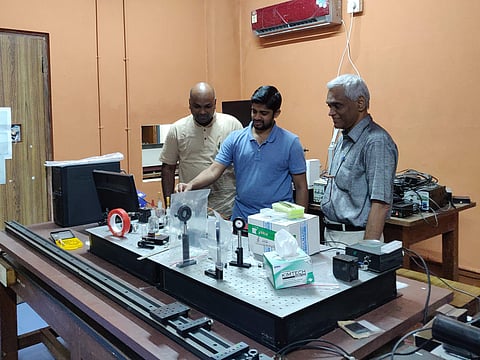

Indian Institute of Technology Madras Researchers have demonstrated the possibility of generating biocompatible lasers from carrots, exploiting a process first discovered by Sir C V Raman who won the Nobel Prize for Physics in 1930. This finding by the IIT Madras team, a first-of-its-kind development even globally, promises significant advancements in scientific and industrial research on optical spectroscopy and sensing. Apart from being bio-friendly, the system they envisage is robust and reliable, with good and linear response to temperature.
Being completely natural and fully biocompatible, this system can be used with other bio-entities for their sensing based on the proposed laser. Being very robust and highly reliable, this ‘kitchen laser’ has very good and linear response for temperature which could be used for temperature sensing too.
Lasers are ubiquitous sources of light with extraordinary properties such as a high degree of directionality and sharpness. They are indispensable in a dazzling range of products and technologies including communication, lithography, medicine, military operations, scientific research, engineering, displays, and data storage. In this case, a particular class of lasers called ‘random lasers’ have been demonstrated in carrots where a Raman process plays a central role along with the cellulose network.
The Research was undertaken by a team comprising Prof. C. Vijayan, Physics Department, IIT Madras and Dr Sivarama Krishnan, Assistant Professor, Physics Department, IIT Madras, along with Venkata Siva Gummaluri, PhD Research Scholar, Physics department, IIT Madras.
Speaking about the importance of this research, Prof C Vijayan said, “There is now a move towards development of green, sustainable materials for various applications, including in photonics. The need for green photonic technologies in obvious in the current times where sustainability, bio-compatibility and -degradability are of paramount importance.”
Elaborating on their Research, Dr Sivarama Krishnan said, “Organic bio-pigments like carotenoids found in carrots and porphyrins found in chlorophyll are interesting optically active media because of their visible light absorption properties. Although the fluorescence quantum yield of carotenoids is much less compared to standard organic laser dyes, the vibrational spectra can be obtained even with extremely low concentrations of carotenoids. The Research team naturally chose carotenoid, as a possible lasing source.”
Light Amplification by Stimulated Emission of Radiation, more commonly known as LASER, is one of the most important discoveries of the 20th century, as has been shown by its plethora of exciting applications in daily life. Laser is created when electrons in some special materials absorb energy and become ‘excited.’ These electrons emit ‘particles of light’ or photons when they return to their original state. The photons are coherent, which makes the light emitted powerful and sharp. These lasing materials are usually solid-state and semiconductor materials, such as Nd-YAG, which are expensive, and involve environmental issues during production and/or use.
Carrots, in addition to having carotenoids, also have cellulose fibers, that contribute to multiple scattering of photons and resultant optical amplification for Raman random lasing. They were not wrong in their expectation.
How this 19-year-old made Chennaiites proud by winning the top honour in the army wing of NCC
IIT Mandi researchers find the target protein for action of antimalarial drug against Zika Virus
Sad masks, candlelight march mark tenth day of protests by researchers at IIT Delhi
Aalok Khandekar, IITH researcher is coordinating an air pollution governance study on Indian cities
These IIT Madras profs launch start-up to train students on Artificial Intelligence at nominal costs
This IITM start-up is lighting up villages in remote corners of the country
